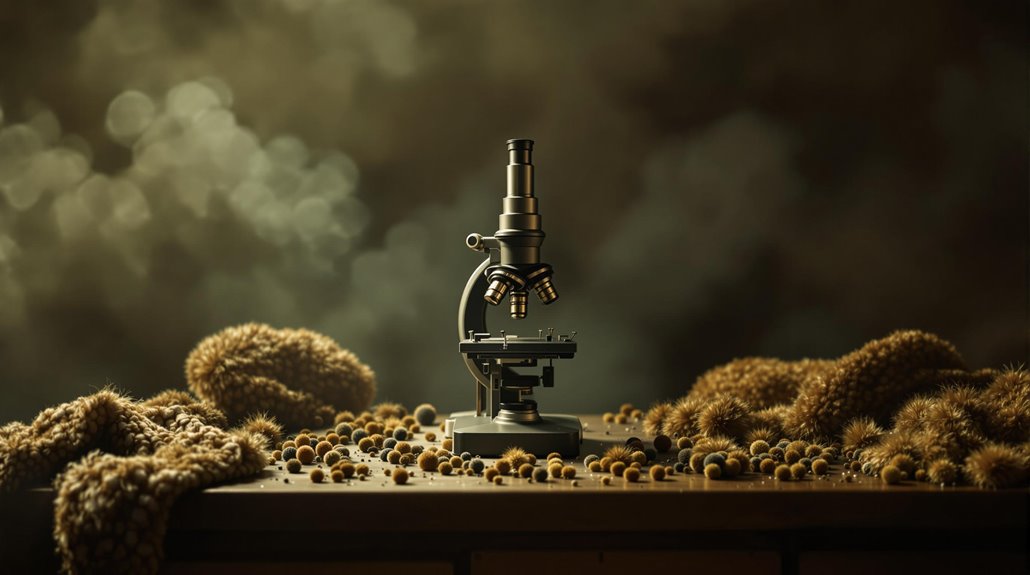George De Mestral’S Burr Obsession: How a Pet-Fur Nightmare Became Velcro
Did you know that over 60 million yards of Velcro are produced annually, enough to circle the Earth twice? You've likely used this ubiquitous fastener today, yet its origin story stems from one man's frustration with burrs stuck in his dog's fur. George de Mestral's 1941 hunting trip mishap could have ended in mere annoyance, but his engineer's mindset transformed a natural nuisance into one of the 20th century's most versatile inventions.
A Swiss Engineer's Curious Mind

From his earliest days in Saint-Saphorin-sur-Morges, Switzerland, George de Mestral displayed an extraordinary talent for innovation. His curiosity-driven inventions began at just 12 years old when he patented his first creation – a toy airplane design.
You'll find his childhood creativity wasn't just a passing phase; it shaped his entire future.
While working odd jobs to fund his education at École polytechnique fédérale de Lausanne, de Mestral's innovative spirit continued to flourish. After graduating as an electrical engineer in 1930, he gained hands-on experience in a machine shop, further developing his problem-solving abilities. His fateful winter walk in 1948 with his dog would lead to examining burrs microscopically.
His keen interest in natural phenomena and mechanical solutions would later prove invaluable. Coming from a family where his father worked as an agronomist engineer, de Mestral's scientific mindset seemed almost inevitable. After his father's passing in 1966, he inherited the distinguished château Saint-Saphorin-sur-Morges.
The Alps Hunting Trip That Changed Everything
While on a winter hunting expedition in 1941, George de Mestral and his Irish Pointer trekked through Switzerland's Jura mountains, unaware they'd stumble upon an invention that would revolutionize fastening technology.
Among the hunting challenges that day, de Mestral encountered an unexpected annoyance: his clothes and his dog's fur became covered in persistent burdock burrs.
Instead of merely brushing off this inconvenience, his engineer's mind sparked with curiosity. You might say nature inspiration struck when he examined these pesky burrs under closer inspection, discovering their remarkable hooking mechanism that made them cling so effectively to fabric and fur.
This seemingly mundane observation would launch de Mestral into a decade-long journey of developing what we now know as Velcro, transforming a simple seed's design into a revolutionary fastening system. After studying the burrs through a microscopic examination, he discovered the tiny hooks that would become the foundation of his groundbreaking invention. His determination led to the creation of over 400 patents related to his revolutionary fastening system.
From Nature's Design to Laboratory Tests
After discovering the burrs' remarkable clinging ability, de Mestral launched into meticulous laboratory analysis that would form the foundation of his revolutionary invention.
Under the microscope, he observed thousands of tiny hooks on each burr that effortlessly latched onto clothing and dog fur. This burr structure became his blueprint for innovation.
Taking nature inspiration to the laboratory, he partnered with a Lyon fabric manufacturer to recreate this ingenious design.
De Mestral's degree in engineering from EPFL helped him understand the technical aspects of recreating nature's design.
You'll appreciate how he selected nylon as his material of choice, crafting hooks that mimicked the burr's flexibility and strength.
Through years of prototyping, he tested various hook shapes and loop materials, including cotton velvet, to achieve the perfect combination.
It was a painstaking process of refinement until he developed a reliable, reusable fastening system.
The breakthrough came when he discovered that infrared light treatment could create durable hooks in the nylon material.
Technical Hurdles and Breakthroughs
Despite having a clear vision for his hook-and-loop fastener, de Mestral faced significant manufacturing challenges that threatened to derail his invention.
You'll find that his manufacturing innovations required designing entirely new machinery to create consistent, tiny hooks on a massive scale. After discovering cotton's limitations, material advancements led to nylon's adoption, offering superior strength and versatility. The velour and crochet terminology would eventually inspire the product's iconic name. The inventor's early struggles were reflected in his meager earnings of US$ 60 per week during the initial development phase.
Key developments that shaped Velcro's success:
- Creation of specialized looms and hook-cutting systems
- Development of mechanized weaving processes
- Discovery of precise nylon-cutting angles
- Implementation of two-strip design architecture
- Integration of nylon-cotton hybrid materials
Through a decade of persistent research and development, de Mestral perfected a fastening system capable of supporting 80 kg with just a small piece, setting new industry standards for hook-and-loop performance and reliability.
Building a Global Hook-and-Loop Empire

The technical breakthroughs in Velcro's manufacturing set the stage for its remarkable global expansion. Starting with the formation of Velcro S.A. in Switzerland in 1952, the company quickly established a presence in global markets through strategic alliances and new manufacturing facilities.
You'll find it fascinating that within just five years, they'd expanded to New Hampshire, Quebec, and Spain. The development of nylon-based hooks proved to be a crucial innovation that enabled mass production capabilities. The company's early success was driven by de Mestral's collaboration with weavers in Lyon to perfect the manufacturing process.
An essential turning point came in 1957 when they partnered with Velok Ltd., securing exclusive rights for the Western Hemisphere and Asia-Pacific regions.
By 1967, the merger of Velok and Velcro created an even stronger international presence. The company's growth was explosive – from de Mestral's modest $60 weekly earnings to impressive revenues of $298 million by 2008.
Through strategic partnerships and continuous expansion, they'd built a truly global hook-and-loop empire.
A Natural Innovation's Lasting Impact
While hiking through the Alps in 1941, George de Mestral's encounter with stubborn burdock burrs led to one of history's most significant biomimicry innovations.
His decade-long journey of observation and experimentation revolutionized fastening technology and opened doors to countless sustainable innovations. In fact, his microscopic examination revealed the tiny elastic hooks that would become the foundation of his invention. After extensive testing, he determined that nylon material would provide optimal durability for the hooks.
Today, you'll find Velcro's biomimicry applications across multiple industries:











